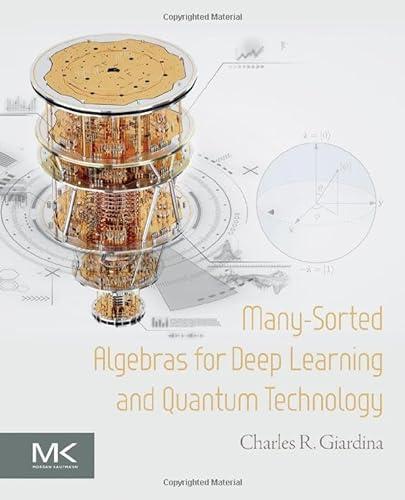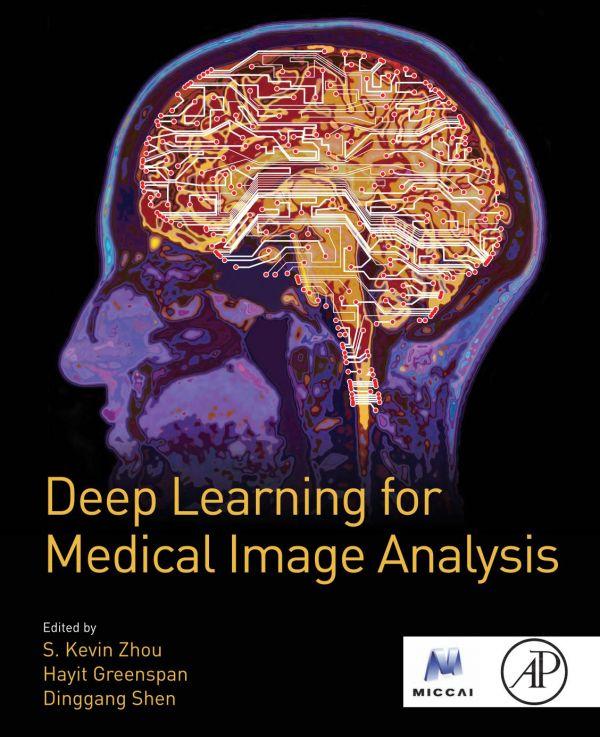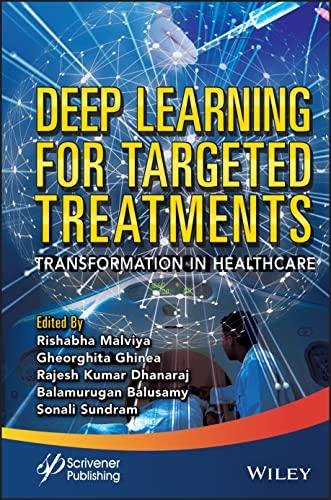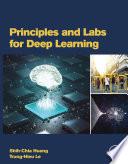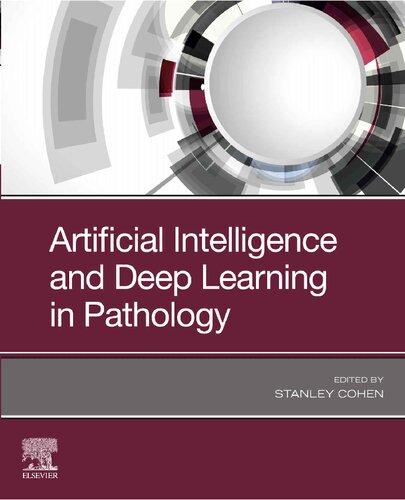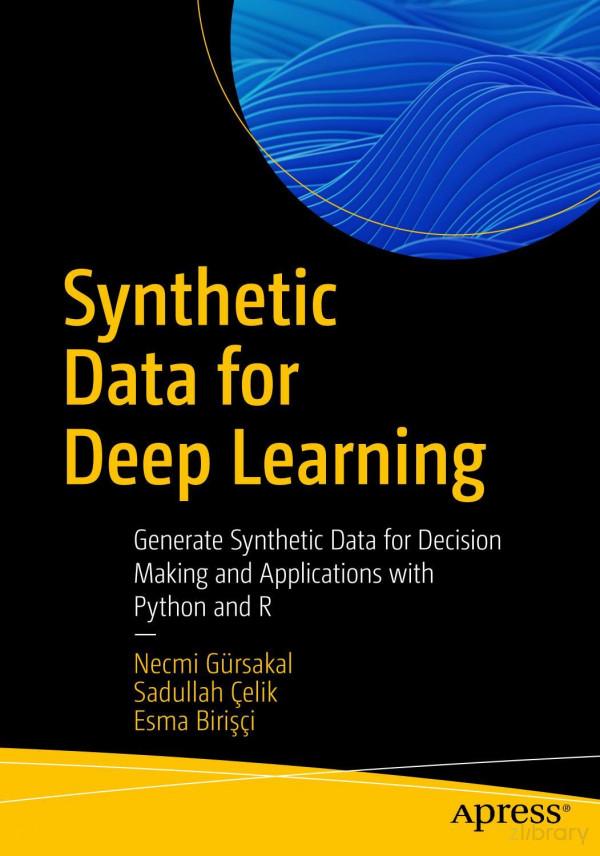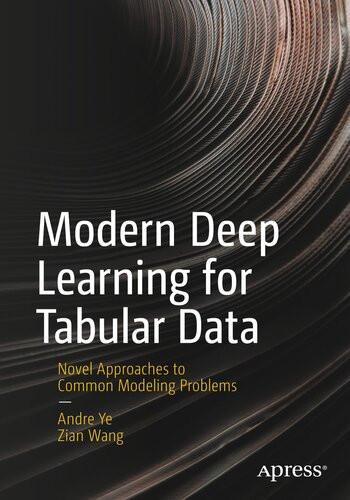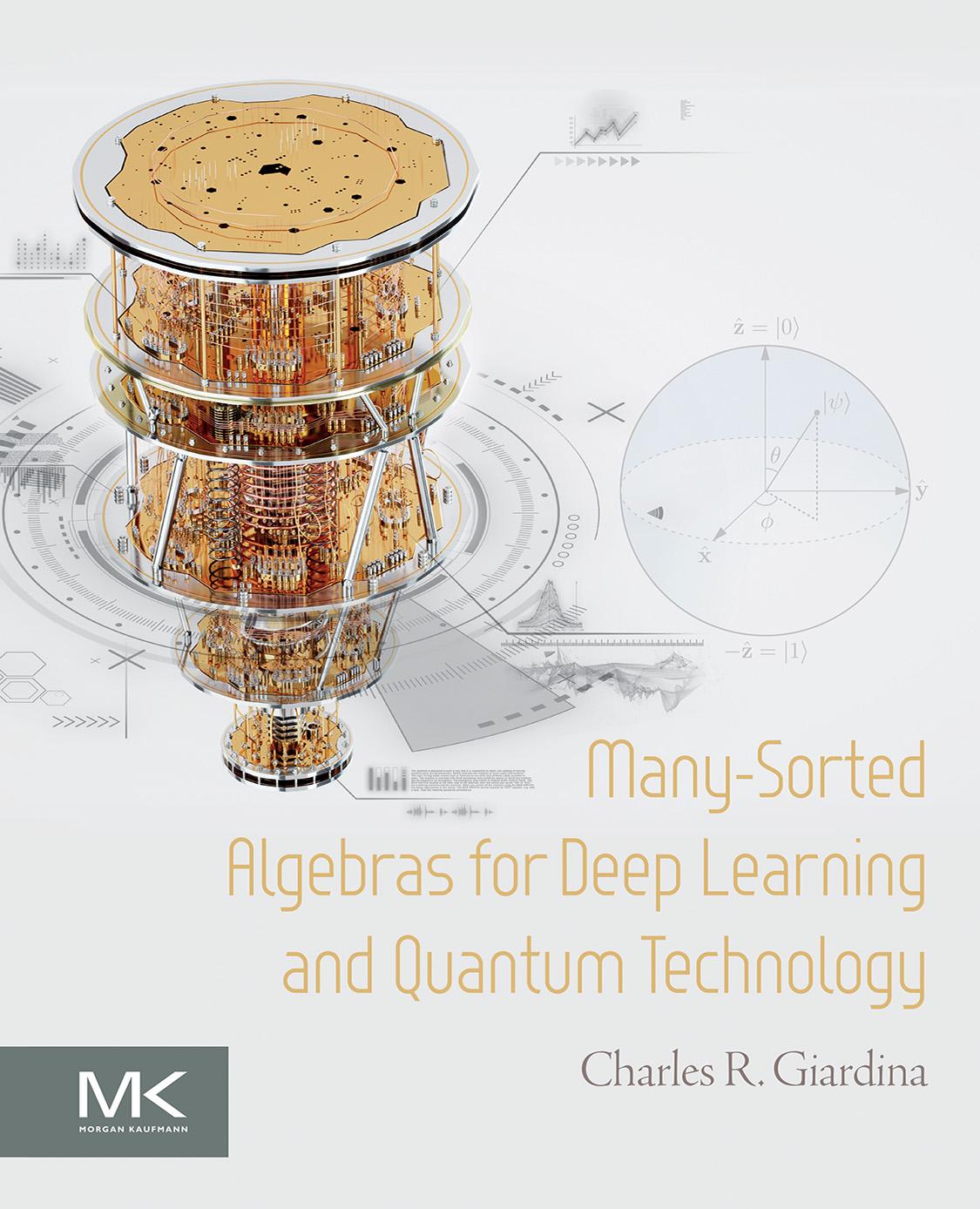1st Edition Giardina Ph.D. Visit to download the full and correct content document: https://ebookmass.com/product/many-sorted-algebras-for-deep-learning-and-quantu m-technology-1st-edition-giardina-ph-d/
More products digital (pdf, epub, mobi) instant download maybe you interests ...
Deep Learning for Medical Image Analysis 1st Edition S. Kevin Zhou
https://ebookmass.com/product/deep-learning-for-medical-imageanalysis-1st-edition-s-kevin-zhou/
Photonanotechnology for Therapeutics and Imaging 1st Edition Ph.D. Choi
https://ebookmass.com/product/photonanotechnology-fortherapeutics-and-imaging-1st-edition-ph-d-choi/
Deep Learning for Targeted Treatments : Transformation in Healthcare Rishabha Malviya
https://ebookmass.com/product/deep-learning-for-targetedtreatments-transformation-in-healthcare-rishabha-malviya/
Principles and Labs for Deep Learning 5th Edition ShihChia Huang
https://ebookmass.com/product/principles-and-labs-for-deeplearning-5th-edition-shih-chia-huang/
Artificial Intelligence and Deep Learning in Pathology 1st Edition Stanley Cohen Md (Editor)
https://ebookmass.com/product/artificial-intelligence-and-deeplearning-in-pathology-1st-edition-stanley-cohen-md-editor/
From Deep Learning to Rational Machines 1st Edition
Cameron J. Buckner
https://ebookmass.com/product/from-deep-learning-to-rationalmachines-1st-edition-cameron-j-buckner/
Synthetic Data for Deep Learning: Generate Synthetic Data for Decision Making and Applications with Python and R 1st Edition Necmi Gürsakal
https://ebookmass.com/product/synthetic-data-for-deep-learninggenerate-synthetic-data-for-decision-making-and-applicationswith-python-and-r-1st-edition-necmi-gursakal-2/
Synthetic Data for Deep Learning: Generate Synthetic Data for Decision Making and Applications with Python and R 1st Edition Necmi Gürsakal
https://ebookmass.com/product/synthetic-data-for-deep-learninggenerate-synthetic-data-for-decision-making-and-applicationswith-python-and-r-1st-edition-necmi-gursakal/
Modern Deep Learning for Tabular Data: Novel Approaches to Common Modeling Problems 1st Edition Andre Ye
https://ebookmass.com/product/modern-deep-learning-for-tabulardata-novel-approaches-to-common-modeling-problems-1st-editionandre-ye/
MANY-SORTEDALGEBRASFORDEEP LEARNINGANDQUANTUM TECHNOLOGY Thispageintentionallyleftblank
MANY-SORTED ALGEBRASFOR DEEPLEARNING ANDQUANTUM TECHNOLOGY CHARLES R.GIARDINA LucentTechnologies,Whippany,NJ,UnitedStates(Retired)
MorganKaufmannisanimprintofElsevier
50HampshireStreet,5thFloor,Cambridge,MA02139,UnitedStates
Copyright©2024ElsevierInc.Allrightsarereserved,includingthosefortextanddatamining,AItraining,andsimilar technologies.
Nopartofthispublicationmaybereproducedortransmittedinanyformorbyanymeans,electronicormechanical, includingphotocopying,recording,oranyinformationstorageandretrievalsystem,withoutpermissioninwritingfromthe publisher.Detailsonhowtoseekpermission,furtherinformationaboutthePublisher’spermissionspoliciesandour arrangementswithorganizationssuchastheCopyrightClearanceCenterandtheCopyrightLicensingAgency,canbefound atourwebsite: www.elsevier.com/permissions.
ThisbookandtheindividualcontributionscontainedinitareprotectedundercopyrightbythePublisher(otherthanasmay benotedherein).
Notices Knowledgeandbestpracticeinthisfieldareconstantlychanging.Asnewresearchandexperiencebroadenour understanding,changesinresearchmethods,professionalpractices,ormedicaltreatmentmaybecomenecessary.
Practitionersandresearchersmustalwaysrelyontheirownexperienceandknowledgeinevaluatingandusingany information,methods,compounds,orexperimentsdescribedherein.Inusingsuchinformationormethodstheyshouldbe mindfuloftheirownsafetyandthesafetyofothers,includingpartiesforwhomtheyhaveaprofessionalresponsibility.
Tothefullestextentofthelaw,neitherthePublishernortheauthors,contributors,oreditors,assumeanyliabilityforany injuryand/ordamagetopersonsorpropertyasamatterofproductsliability,negligenceorotherwise,orfromanyuseor operationofanymethods,products,instructions,orideascontainedinthematerialherein.
ISBN:978-0-443-13697-9
ForInformationonallMorganKaufmannpublications visitourwebsiteat https://www.elsevier.com/books-and-journals
Publisher: MaraConner
AcquisitionsEditor: ChrisKatsaropoulos
EditorialProjectManager: JohnLeonard
ProductionProjectManager: SelvarajRaviraj
CoverDesigner: MatthewLimbert
TypesetbyMPSLimited,Chennai,India
Dedication Tomyeverything,Betty Thispageintentionallyleftblank
Contents Listoffiguresxi
Prefacexv
Acknowledgmentsxvii
1.Introductiontoquantummany-sorted algebras1
1.1Introductiontoquantummany-sortedalgebras1
1.1.1Algebraicstructures1
1.1.2Many-sortedalgebramethodology2
1.1.3Globalfieldstructure3
1.1.4Globalalgebraicstructuresinquantum andinmachinelearning5
1.1.5Specificmachinelearningfield structure6
1.1.6Specificquantumfieldstructure7
1.1.7Vectorspaceasmany-sortedalgebra8
1.1.8FundamentalillustrationofMSAin quantum12
1.1.9Time-limitedsignalsasaninner productspace13
1.1.10KernelmethodsinrealHilbert spaces15
1.1.11R-Modules17 References19
2.Basicsofdeeplearning21
2.1Machinelearninganddatamining21
2.2Deeplearning23
2.3Deeplearningandrelationshiptoquantum23
2.4Affinetransformationsfornodeswithin neuralnet24
2.5Globalstructureofneuralnet24
2.6Activationfunctionsandcostfunctionsfor neuralnet28
2.7Classificationwithasingle-nodeneuralnet30
2.8Backpropagationforneuralnetlearning31
2.9Many-sortedalgebradescriptionofaffine space35
2.10Overviewofconvolutionalneuralnetworks37
2.11Briefintroductiontorecurrentneural networks38
References40
3.Basicalgebrasunderlyingquantumand NNmechanisms41
3.1Fromavectorspacetoanalgebra41
3.2Analgebraoftime-limitedsignals44
3.3Thecommutantinanalgebra47
3.4Algebrahomomorphism47
3.5Hilbertspaceofwraparounddigitalsignals48
3.6Many-sortedalgebradescriptionofaBanach space49
3.7Banachalgebraasamany-sortedalgebra51
3.8Many-sortedalgebraforBanach*andC* algebra52
3.9Banach*algebraofwraparounddigital signals53
3.10Complex-valuedwraparounddigital signals54 References55
4.QuantumHilbertspacesandtheir creation57
4.1ExplicitHilbertspacesunderlyingquantum technology57
4.2Complexification58
4.3Dualspaceusedinquantum60
4.4DoubledualHilbertspace64
4.5Outerproduct66
4.6Multilinearforms,wedge,andinterior products68
4.7Many-sortedalgebrafortensorvectorspaces71
4.8Thedeterminant73
4.9Tensoralgebra74
4.10Many-sortedalgebrafortensorproductof Hilbertspaces76
4.11Hilbertspaceofrays78
4.12Projectivespace79 References81
5.Quantumandmachinelearning applicationsinvolvingmatrices83
5.1Matrixoperations83
5.2Qubitsandtheirmatrixrepresentations85
5.3ComplexrepresentationfortheBloch sphere91
5.4Interior,exterior,andLiederivatives92
5.5SpectraformatricesandFrobeniuscovariant matrices93
5.6Principalcomponentanalysis94
5.7Kernelprincipalcomponentanalysis97
5.8Singularvaluedecomposition98 References101
6.Quantumannealingandadiabatic quantumcomputing103
6.1Schrodinger’scharacterizationof quantum103
6.2Quantumbasicsofannealingandadiabatic quantumcomputing105
6.3Deltafunctionpotentialwelland tunneling107
6.4Quantummemoryandtheno-cloning theorem110
6.5Basicstructureofatomsandions111
6.6Overviewofqubitfabrication114
6.7Trappedions116
6.8Super-conductanceandtheJosephson junction117
6.9Quantumdots121
6.10D-waveadiabaticquantumcomputersand computing122
6.11Adiabatictheorem124 Reference128 Furtherreading129
7.OperatorsonHilbertspace131 7.1Linearoperators,aMSAview131
7.2ClosedoperatorsinHilbertspaces135
7.3Boundedoperators135
7.4Puretensorsversuspurestate operators138
7.5Traceclassoperators141
7.6Hilbert-Schmidtoperators142
7.7Compactoperators143 References144
8.Spacesandalgebrasforquantum operators145
8.1BanachandHilbertspacerank,boundedness, andSchauderbases145
8.2CommutativeandnoncommutativeBanach algebras147
8.3SubgroupinaBanachalgebra149
8.4BoundedoperatorsonaHilbertspace151
8.5Invertibleoperatoralgebracriteriaona Hilbertspace153
8.6SpectruminaBanachalgebra155
8.7IdealsinaBanachalgebra157
8.8Gelfand-Naimark-Segalconstruction158
8.9GeneratingaC*algebra162
8.10TheGelfandformula163
References164
9.VonNeumannalgebra165 9.1Operatortopologies165
9.2TwobasicvonNeumannalgebras166
9.3CommutantinavonNeumannalgebra167
9.4TheGelfandtransform168 References169
10.Fiberbundles171 10.1MSAforthealgebraicquotientspaces171
10.2Thetopologicalquotientspace173
10.3Basictopologicalandmanifold concepts176
10.4Fiberbundlesfrommanifolds178
10.5Sectionsinafiberbundle180
10.6Lineandvectorbundles181
10.7Analyticvectorbundles182
10.8EllipticcurvesoverC183
10.9Thequaternions184
10.10Hopffibrations186
10.11HopffibrationwithblochsphereS2,the one-qubitbase187
10.12HopffibrationwithsphereS4,thetwo-qubit base188
References188
11.LiealgebrasandLiegroups191 11.1Algebraicstructure191
11.2MSAviewofaLiealgebra191
11.3DimensionofaLiealgebra192
11.4IdealsinaLiealgebra194
11.5RepresentationsandMSAofaLiegroupofa Liealgebra197
11.6Briefingontopologicalmanifoldpropertiesof aLiegroup198
11.7FormaldescriptionofmatrixLiegroups202
11.8MappingsbetweenLiegroupsandLie algebras208
11.9ComplexificationofLiealgebras215 References216
12.Fundamentalanduniversalcovering groups217 12.1Homotopyagraphicalview217
12.2Initialpointequivalenceforloops219
12.3MSAdescriptionofthefundamental group220
12.4Illustratingthefundamentalgroup225
12.5Homotopicequivalencefortopological spaces226
12.6Theuniversalcoveringgroup227
12.7TheCornwellmapping229 References230
13.Spectraforoperators231 13.1Spectralclassificationforbounded operators231
13.2SpectraforoperatorsonaBanach space233
13.3Symmetric,self-adjoint,andunbounded operators236
13.4Boundedoperatorsandnumerical range239
13.5Self-adjointoperators241
13.6Normaloperatorsandnonbounded operators243
13.7Spectraldecomposition246
13.8Spectraforself-adjoint,normal,andcompact operators248
13.9Purestatesanddensityfunctions249
13.10Spectrumandresolventset250
13.11Spectrumfornonboundedoperators251
13.12Briefdescriptionsofspectralmeasuresand spectraltheorems252
References253
14.Canonicalcommutation relations255
14.1Isometriesandunitaryoperations255
14.2Canonicalhypergroups—amultisorted algebraview257
14.3Partialisometries259
14.4Multisortedalgebraforpartial isometries260
14.5Stone’stheorem263
14.6Positionandmomentum264
14.7TheWeylformofthecanonical commutationrelationsandtheHeisenberg group265
14.8Stone-vonNeumannandquantum mechanicsequivalence266
14.9Symplecticvectorspace—amultisorted algebraapproach267
14.10TheWeylcanonicalcommutationrelations CT algebra269 References270
15.Fockspace271 15.1ParticleswithinFockspacesandFockspace structure271
15.2Thebosonicoccupationnumbersandthe ladderoperators272
15.3ThefermionicFockspaceandthefermionic ladderoperators276
15.4TheSlaterdeterminantandthecomplex Cliffordspace278
15.5Mayadiagrams278
15.6Mayadiagramrepresentationoffermionic Fockspace283
15.7Youngdiagramsrepresentingquantum particles285
15.8Bogoliubovtransform286
15.9Parafermionicandparabosonicspaces286
15.10Segal Bargmann Fockoperations287
15.11Many-bodysystemsandtheLandaumanybodyexpansion287
15.12Single-bodyoperations288
15.13Two-bodyoperations288 References288
16.Underlyingtheoryforquantum computing291
16.1Quantumcomputingandquantum circuits291
16.2Single-qubitquantumgates292
16.3Paulirotationaloperators295
16.4Multiple-qubitinputgates297
16.5Theswappingoperation299
16.6Universalquantumgateset299
16.7TheHaarmeasure300
16.8Solovay Kitaevtheorem301
16.9QuantumFouriertransformandphase estimation302
16.10Uniformsuperpositionandamplitude amplification303
16.11Reflections304
References305
17.Quantumcomputing applications307
17.1Deutschproblemdescription307
17.2OracleforDeutschproblemsolution308
17.3QuantumsolutiontoDeutschproblem309
17.4Deutsch-Jozsaproblemdescription310
17.5QuantumsolutionfortheDeutsch-Jozsa problem311
17.6Groversearchproblem312
17.7SolutiontotheGroversearchproblem313
17.8TheShor’scryptographyproblemfroman algebraicview315
17.9SolutiontotheShor’sproblem317
17.10Ellipticcurvecryptography318
17.11MSAofellipticcurveoverafinite field321
17.12Diffie HellmanEECkeyexchange324 References325 Furtherreading325
18.Machinelearninganddata mining327
18.1Quantummachinelearning applications327
18.2Learningtypesanddatastructures328
18.3Probablyapproximatelycorrectlearningand Vapnik-Chervonenkisdimension329
18.4Regression332
18.5K-nearestneighborclassification334
18.6K-nearestneighborregression335
18.7QuantumK-meansapplications336
18.8Supportvectorclassifiers336
18.9Kernelmethods339
18.10Radialbasisfunctionkernel341
18.11Boundmatrices341
18.12Convolutionalneuralnetworksandquantum convolutionalneuralnetworks346 References348
19.ReproducingkernelandotherHilbert spaces349
19.1Algebraicsolutiontoharmonic oscillator349
19.2ReproducingkernelHilbertspaceoverCand thediskalgebra350
19.3ReproducingkernelHilbertspaceover R354
19.4Mercer’stheorem355
19.5Spectraltheorems357
19.6TheRiesz-Markovtheorem361
19.7SomenonseparableHilbertspaces362
19.8SeparableHilbertspacesareisometrically isomorphictol2 363 References364
AppendixA:Hilbertspaceofwraparound digitalsignals365
AppendixB:Multisortedalgebraforthe descriptionofameasurableandmeasure spaces369
AppendixC:EllipticcurvesandAbelian groupstructure373
AppendixD:Youngdiagrams377
AppendixE:Youngdiagramsandthe symmetricgroup379
AppendixF:Fundamentaltheoremsin functionalanalysis383
AppendixG:Sturm Liouvilledifferential equationsandconsequences387
Index391
Listoffigures Figure1.1Polyadicgraphforthefieldstructure.4
Figure1.2Vectorspacedescribedasmany-sortedalgebra.8
Figure1.3InnerproductorHilbertspace.13
Figure1.4(A)OriginaldatainR2 and(B)featuremappeddatainR3.15
Figure2.1MatrixstructureforNNsquarewavepulsecreation. NN,Neuralnet.26
Figure2.2SymbolicschemaforoperationswithinNNnodes. NN,Neuralnet.27
Figure2.3SymboliccalculationsforNNsquarewavepulsecreation. NN,Neuralnet.28
Figure2.4ClassificationusingNNwithnoncontinuousactivation. NN,Neuralnet.31
Figure2.5ClassificationusingNNwithsigmoidactivation. NN,Neuralnet.32
Figure2.6BiasandweightmodificationsforsinglenodeNN. NN,Neuralnet.33
Figure2.7Polyadicgraphofaffinespace.36
Figure2.8Typesofrecurrentneuralnetworks.(A)RNN,(B)LSTM,(C)GRU.39
Figure3.1Polyadicgraphofaunitalalgebra.42
Figure3.2Parallelconvolutionalgorithm.45
Figure3.3PolyadicgraphforaBanachspace.50
Figure3.4PolyadicgraphforoperatornamesinaBanachalgebra.51
Figure3.5PolyadicgraphofoperatorsinaBanach*orC*algebra.53
Figure4.1Polyadicgraphforcomplexification.59
Figure4.2Polyadicgraphforillustratingdualspacecreation.61
Figure4.3GraphrelatingketandbraHilbertspaces.65
Figure4.4Canonicalisomorphicmapfordoubledual.65
Figure4.5Polyadicgraphsillustratingouterproduct.67
Figure4.6Tensorvectorspace. 72
Figure4.7Operationsinvolvingtensors.75
Figure4.8TensorproductofHilbertspaces.76
Figure5.1Polyadicgraphinvolvingmatrixoperations.83
Figure5.2Illustrationofidenticaloperandsinpolyadicgraph.86
Figure5.3Blochsphere. 87
Figure6.1Boundstateandscatteringstatetunnelingeffect.(A)Boundstate,(B)Scatteringstate,(C) Normalizedboundstatesolution,(D)Tunnelingeffect. 108
Figure6.2Cooperpairtunneling.Basedon(Frolov,2014),(A)FrolovBarrie,(B)CooperPair Tunneling,(C)Voltage-CurrentDeadZone.
118
Figure6.3(A)ParallelCircuit,(B)Energylevelswithincosinetypeboundary.120
Figure6.4AdiabaticprocessfollowingZwiebach,(A)Hamiltonian,(B)EnergySeparation,(C)Path CrossingHamiltonian,(D)NonCrossingPaths. 126
Figure7.1SimpleelementsinH1 H2andpurestates.138
Figure8.1PolyadicgraphforsubgroupinBanachalgebra.150
Figure8.2Continuousspectrum. 156
Figure8.3Leftandrightideals. 157
Figure8.4GraphforhomomorphismsinvolvingC*algebra.158
Figure8.5GNSconstructionbetweenAC*algebraandaHilbertspace. GNS,Gelfand-Naimark-Segal.160
Figure10.1Generalandspecificalgebraicquotientspaces.(A)Mappingsinquotientspace,(B) quotientspace,lineinplane. 172
Figure10.2Homeomorphismofquotientspaceofreals.174
Figure10.3Homeomorphisminvolvingcircularinterval.175
Figure10.4Nonfirstcountablespace.176
Figure10.5Manifoldwithtwochartsandtransitionmapping.177
Figure10.6Mobiusstickfigure. 178
Figure10.7Mobiusstrip. 179
Figure10.8Sectionsinafiberbundle.181
Figure10.9Trivializationinalinebundle.182
Figure10.10Twotypesoflattices.(A)Squarepatternlattice,(B)moregenerallattice.183
Figure10.11HopffibrationS0 - S1 - S1.(A)Originalcircle;(B)Twistappliedtocircle;(C)Folding operation. 187
Figure11.1LiealgebraMSAgraph.192
Figure11.2LiegroupMSAgraph. 198
Figure11.3Pathconnectivity. 200
Figure11.4MappingsbetweenLiegroupsandaLiealgebra.208
Figure12.1Homotopysquare. 218
Figure12.2Exampleofhomotopywithloopstouchingonlyattheorigin.218
Figure12.3Equivalenceclassesforloops.219
Figure12.4Initialpointequivalence.220
Figure12.5Polyadicgraphforthefundamentalgroup.221
Figure12.6Equivalentclassesarewelldefined.222
Figure12.7Proofoftheassociatedlaw.222
Figure12.8Identitycondition. 223
Figure12.9Inversefunctionequationalidentity.224
Figure12.10Figureeight. 226
Figure12.11Universalcoveringgroup.228
Figure13.1SpectraforoperatorLinl1 anditsdualinlN.236
Figure14.1Canonicalhypergrouppolyadicgraph.257
Figure14.2Partialisometrymappings.259
Figure14.3Polyadicgraphforpartialisometry[U,U*]nonzero.261
Figure14.4Polyadicgraphforasymplecticvectorspace.267
Figure15.1LadderoperatorsforFockspaces.(A)BosonicFockspace,(B)Allowableoperationsin FermionicFockspace. 274
Figure15.2YoungdiagramobtainedfromtheMayadiagram(seeExample15.9).279
Figure15.3YoungdiagramtofindMayadiagram.282
Figure16.1Hilbertgroup.
Figure16.2CNOTgate.
Figure16.3TheSWAPGate.
Figure16.4Traceofamplitudeamplification.(A)Uniformsuperposition,(B)Reflectionofthestate| x*.,(C)Amplitudeamplification,(D)Oneandahalfreflectionpairsappliedagain,(E) Tworefectionpairsapplied/.
Figure16.5Reflectionoperation.:(A)Twovectorsandreflectionket,(B)Resultofreflectionoperation.305
Figure17.1Deutschoracle. 307
Figure17.2QuantumcircuitsrepresentingDeutschoracle.309
Figure17.3Deutschalgorithm. 309
Figure17.4Deutsch-Jozsaalgorithm.311
Figure17.5Groverreflectionoperations.(A)Startingposition,(B)ApplicationofOracle,(C)Reflection applied,(D)ApplicationofOracleagain,(E)Reflectionappliedagain,(F)Oracleapplied, (G)Reflectionapplied. 314
Figure17.6Typesofellipticcurves.322
Figure18.1Shatteringone,two,andthreepointsbyAffinemanifold:(A)shatteringasinglepoint;(B) shatteringtwopoints;(C)shatteringthreepoints. 331
Figure18.2Shatteringfourpointsbyarectangle.332
Figure18.3K-nearestneighborclassification.334
Figure18.4Convolutionalneuralnetwork.347
Figure19.1Thefirstfivewavefunctionsfortheharmonicoscillator.350
FigureB.1(A)Measurablespaceand(B)measurespace.369
FigureC.1Ellipticcurveaddition. 373
FigureC.2Additionofverticalpointsonanellipticcurve.374
FigureC.3Proofofassociativelaw.375
FigureD.1Youngdiagram. 378
FigureE.1Youngdiagramofpermutationgroup.380
Preface Many-sortedalgebra(MSA)providesa rigorousplatformfordescribingandunifyingvariousalgebraicstructuresinseveral branchesofscience,engineering,andmathematics.However,themostnaturalapplicationfortheuseofthisplatformisinall areasofquantumtechnologies.These includequantumphysics,quantum mechanics,quantuminformationtheory amongthemostrecent,quantumcomputing,quantumneuralnets,andquantum deeplearning.Indeed,inallquantumdisciplines,thereexistsanabundanceofalgebraicunderpinningsandtechniques. Severalofthesetechniquesaredirectly applicabletomachinelearningandarepresentedherein.Inparticular,withthecurrentinterestinquantumconvolutional neuralnetworks,understandingofbasic quantumbecomesallthemoreimportant. Althoughanalytical,topological,probabilistic,aswellasgeometricalconceptsare employedinmanyofthesedisciplines, algebraexhibitstheprincipalthread.This threadisexposedusingtheMSA.
AfundamentalsettingofHilbertspace overacomplexfieldisessentialinallof quantum,whilemachinelearningdeals predominantlywiththerealfield.Botha globallevelandalocallevelofprecise specificationaredescribedintheMSA. Indeed,characterizationsatalocallevel duetodistinctcarriersetsmayappearvery different,butatagloballeveltheymaybe
identical.Banach*algebrasaswellas Hilbertspacesarebasictothesesystems. Fromalocalview,thesealgebrasmaydiffergreatly.Forinstance,theBanach algebra-typebilinearmultiplicationoperationintheneuralnetworkmightinvolve anaffinemaporitcouldbeconvolution. However,inquantumsystems,thebilinear operationoftentakesadditionalforms. Theseincludepoint-wisemultiplication, functioncomposition,LieorPoissonbrackets,orevenaconcatenationofequivalence classesofpathsinhomotopy.
Theoreticalaswellaspracticalresults areprovidedthroughoutthistext.Hilbert spaceraysactingasstates,aswellasanindepthdescriptionofqubits,areexplained andillustrated.Qubitsformacenterstage inquantumcomputingandquantum machinelearning.UnitaryoperatorsformingagroupareemployedinstatetransitionsandaredescribedintheMSAas HilbertandLiegroups.Parameterswithin unitaryoperatorsallowoptimizationin quantumcomputingapplications. Concurrently,C*algebrasdescribedinthe MSAembracethestructureofobservables. Inallcases,theMSAsaremostusefulin illustratingtheinterplaybetweentheseand thevariousotheralgebraicstructuresin quantumandmachinelearningdisciplines.
CharlesR.Giardina
Thispageintentionallyleftblank
Acknowledgments IamthankfultoEdCookeforreading thepreliminarychaptersandtothe reviewersfortheirconstructiveimprovements.ThanksarealsoduetotheElsevier editorialstafffortheirassistanceandhelpfulguidancethroughout.Finally,Iammost
appreciativeofknowingandlearningfrom thethreegreatmathematicians/engineers andallone-timeBellTelephone Laboratories’colleagues:DavidJagerman, CharlesSuffel,andFrankBoesch.
Thispageintentionallyleftblank
Introductiontoquantummany-sorted algebras 1.1Introductiontoquantummany-sortedalgebras
Thischapterbeginsbymentioningseveralalgebraicstructuresdescribedinthelater sectionsofthetextthatwillbeembeddedintoaversionofthemany-sortedalgebra.This isfollowedbyadescription,aswellasanillustrationofthemany-sortedalgebramethodology.AglobalviewinvolvingtheMSAisgivenusingpolyadicgraphsconsistingof nodeswithmanytaileddirectedarrows.Thegeneralfieldstructureisdescribedin Section1.1.4,intermsoftheMSA.Thisisfollowedbyfurtheralgebraicstructuresinquantumandmachinelearning.Specificquantumandmachinelearningfieldsarepresented alongwithgeneralHilbertspaceconditionsthatunderlyallquantummethodology.Timelimitedsignalsaredevelopedunderinnerproductspaceconditions.Thesesignalsare basicconstructsforconvolutionalneuralnetworks.Kernelmethods,usefulinbothquantumandmachinelearningdisciplines,arepresented.Inlaterchapters,kernelmethodsare showntobeafundamentalingredientinsupportvectormachines.Thischapterendswith adescriptionandapplicationofRmodules.ThesestructureshaveanMSAdescription almostidenticaltoavectorspacestructure.
1.1.1Algebraicstructures Throughoutquantum,anextremelywidevarietyofalgebraicstructuresareemployed, beginningwiththemostfundamentalcanonicalcommutationrelations(CCR)tomethods forsolvingellipticcurvecryptographyandbuildingquantumconvolutionalneuralnetworks.Itisthepurposeofthistexttoprovideaunificationoftheunderlyingprinciples embeddedwithinthesealgebraicstructures.Themechanismforthisunificationisthe many-sortedalgebra(MSA)(GoguenandThetcler,1973).TheMSAcanbethoughttobe anextensionofuniversalalgebra,asin Gratzer(1969).Here,varietiesofalgebraicstructuresaredescribedinamostgeneralizedsensewithmorphismsshowingcorrespondence betweenobjects.Theunderlyingcharacterizationofthemany-sortedormanytypesof algebraicconceptsinquantumdisciplinesiscapturedsimultaneouslythroughrigorous
specificationaswellaspolyadicgraphswithintheMSA.Thepresentworkisinspiredby BirkhoffandLipson(1970) andtheirheterogeneousalgebras,aswellas(Goguenand Meseguer,1986)remarksontheMSA.
BothagloballevelandlocallevelofprecisespecificationarepresentedusingtheMSA. TheMSAisessentialforabetterunderstandingofquantumanditsrelationshipwith machinelearningandquantumneuralnetworktechniques.TheveryconceptofHilbert spacefromthebeginningaxiomsisdetailedinaprecisebuthigh-levelmanner(Halmos, 1958),whereasunderlyingfieldsforquantumandmachinelearningareveryspecific.In quantum,thisfieldisalmostalwayscomplex;sometimesrealnumbersorevenquaternion numbersareutilized.However,inmachinelearning,itisthefieldofmainlytherealsthat isemployed.Thisisparticularlytruewithsupportvectormachineapplications.
Ingeneral,thequantumHilbertspacecouldbefinitedimensional,itcouldconsistof ketsandbras,anditcouldbeatensorproductofsimilarHilbertspacesorinfinitedimensionalasisL2 orl2 (Halmos,1957).Allofthesestructureswillpreciselybeexploredata locallevel.ThisisagainevidentinspecifyingtheGelfand-Naimark-Segal(GNS)constructionrelatingaC*algebratoaHilbertspace(GelfandandNaimark,1943;Segal,1947). Fromapracticalviewpoint,Hilbertspacesofqubitsaredescribedforuseinaquantum computer(Feynman,1986).Otherapplicationsincludequbitsinquantumneuralnetworks andquantummachinelearning.
1.1.2Many-sortedalgebramethodology TobegindescribingtheMSAmethodology,thesetconsistingofthesortsofobjects mustbespecified.Forinstance,thetermscalarmaybeanelementofthisset.Although thetermscalarisgeneric,itmightrefertoelementsfromafieldsuchastherealorcomplexnumbers.However,itmightalsorepresentaquaternionthatisanelementfroma skewornoncommutativefield.Importantly,foreachsort,therearecarriersets.Itisthese setsthatuniquelyidentifytheprecisetypeofelementsinquestion.Forinstance,verydifferentcarriersetsareusedfortherealfield,thecomplexfield,therationalfield,orafinite fieldthatisemployedincryptography.
Oncethesortsaredeclared,operationalsymbolsmustalsobegiven.Theyareorganizedaselementswithinspecificsignaturesets.Thesesetsareusedinidentifyingcommonattributesamongsymbolssuchastheirarity.Operationalsymbolsdenotetheinterandintrasortmappingslikesymmetrization,annihilation,creation,aswellaselementary operations:addition,multiplication,inversion,andsoon.
Theactualoperatorsutilizedinthesemappingsinvolvespecifiedcarriersetsthatcorrespondtothesorts.Thisisperformedatalowerview.Eachoperatoremployselements fromdesignatedcarriersetsasoperandsinthedomain.Thisistruefortheircodomainas well.Theoperatornameswithinsignaturesetsareenumeratedalongwiththealgebraic laws,rules,equationalidentities,orrelationswhichtheymustobey.Thelawsorequationalidentitiesincludecommutationrules,associativelaws,distributivelaws,nilpotent rules,andvariousothersideconditionsorrelationsnecessaryforrigorousspecification.
AusefulglobalviewinvolvingtheMSAisgivenusingpolyadicgraphsconsistingof nodeswithmanytaileddirectedarrows(GoguenandMeseguer,1986).Allentitiesofthe arrowarelabeled.Eachnodeisdenotedbyacircleinscribedwithaspecificsort.The arrowshaveoperatornamesattachedandareasdeclaredintheirsignatureset.Thenumberoftailsinthearrowcorrespondstothearityoftheoperatorinquestion.Operatorsof arityzerohavenotailsandarelabeledusingthenameofspecialelementsofthesort. Theseincludezero,one,andidentityelement,aswellastoporbottom.Thetailsofan arrowareemanatingfromthespecifieddomainsortscomingfromtheappropriatesignaturesets.Thesingleheadofthearrowpointstothesortofcodomainfortheoperator.In short,thepolyadicdiagramprovidesavisualdescriptionoftheclosureoperationsneeded indescribingthealgebraicstructure.
PartialoperatorsareincludedintheMSA.Thisissimilartowhatisdoneinpartialuniversalalgebra.However,specialnotationsareemployedforoperationsnotdefinedonthe entiredenoteddomainsort.Muchofthisnotationwillbegivenlater.Theinclusionof domain-dependentoperatorsisessentialinquantumsinceeventhepositionandmomentumoperatorsareunbounded.Infinite-dimensionalHilbertspacenecessitiesexplicit domaindeclarationaswellasclosureconditions.Amorebasicinstanceofanoperatornot fullydefinedwillbegivenrightnow.Here,themultiplicativeinverseinafieldisdefined forallvaluesexceptforzero,andthusitisapartialoperator.However,thisoperator existsintheMSA.Moreover,adashedarrowwithasingletailisutilizedinthepolyadic graphdescriptioninthiscase.
1.1.3Globalfieldstructure Correspondingtothefieldstructure,onlythesinglesortSCALARisneeded.Several signaturesetsexist.Theyareorganizedbythearity.Arityreferstothenumberofoperandsorargumentsforoperatorswithinthegivensignatureset.Arityalsoreferstothe numberoftailsofapolyadicarrow.Forbinaryoperators,unlessspecifiedotherwise,they shouldutilizebothargumentsineitherorder.Thereisnorestrictiontowhichargument comesfirst.
Binaryoperation:ADD; MULT fg eachmapsSCALAR 3 SCALAR-SCALAR
Unaryoperation:MINUS; INV fg eachmapsSCALAR-SCALAR
Zero aryoperation:ZERO; ONE fg thesearespecialelementsofthesortSCALAR:
NotethateventhoughINVisapartialfunctionname,itiscontainedinthesamesignaturesetasMINUS;bothareunaryoperatornames. Fig.1.1 providesanillustrationofa high-levelinterpretationofanalgebraicfield.Thisgraphindicatestheclosureoperations. Forinstance,theADDimpliesthattwovaluesfromSCALARarecombinedtogive anothervalueofSCALAR,whereasMINUStakesasinglevalueofSCALARandyields anothersuchvalue.ThearrowpointingfromZEROtoSCALARindicatesthattherehasto beanelementinthefieldwhosenameisZERO.ThesameistrueforONE.Asinuniversal algebra,thenumberofoperationalnamesofaspecificarityisoftenlistedbyafinite
sequenceofnonnegativeintegers.Forageneralfieldstructure,thearitysequenceisgiven asfollows:(2,2,2).Indeed,thefirstentryspecifiesthenumberofzero-aryoperations; hereitis2,whilethenextentryisforthenumberofunaryoperations 5 2andthefinal entryisthenumberofbinaryoperations 5 2.Thelistingprocedureissimilartothe methodofrecordingthenumberoffermionorbosonoccupationalnumbersinFockspace. Thisspacewillbedescribedinlatersections.
Theequationalidentitiesorlawsforafieldaregivenbelow.Here,forconvenience,we denotethesortbyrepresentativesymbolsandalltheoperationalnamesbysuggestive symbols.
SCALARbya,borc. ADDby 1 MULTby MINUSbyINVby/ ZEROby0 ONEby1
Theequationalidentities,laws,orconstrainingequationsforafieldareasfollows:
1) Associativeforaddition:(a 1 (b 1 c)) 5 ((a 1 b) 1 c)
2) Zerolaw:0 1 a 5 a 1 0 5 a
3) Minuslaw:forany,athereis a,wherea a 52 a 1 a 5 0
4) Commutativelawforadditionofallelements:a 1 b 5 b 1 a
5) Associativelawformultiplication:(a (b c)) 5 ((a b) c)
6) Distributivelaws:a (b 1 c) 5 a b 1 a c;(a 1 b) c 5 a c 1 b c
7) Onelaw:1 a 5 a 1 5 a
8) Partialinverselaw,exclude0:foranya,thereis1/awhere:a 1/a 5 (1/a) a 5 1
9) Commutativelawformultiplication:a b 5 b a.
AnexampleofanabstractfieldF3 willbegiventoillustratetheclosureoperations, whichistheessenceof Fig.1.1.Alsoillustratedarethenine,equationalconstraintslisted earlier.Theexampleisimportantinthepreparationforthedevelopmentofellipticcurve cryptographyandShor’squantumalgorithmdescribedinalaterchapter.
FIGURE1.1 Polyadicgraphforthefieldstructure.
ConsiderthecarriersetforSCALARtobethesetX 5 {0,1,2}.Operationscorrespondingtothosenamedinthesignaturesetsaredefinedasmodularthree.Thefollowing tablesprovidethebinaryADD,MULT,andtheunaryoperationMINUS,aswellasthe partialunaryoperationINV;thesearelistedinorderasfollows:
Tousethefirsttwotablestofindtheelementstotheleftandaboveforwhichthe binaryoperationistobeperformed,theresultislocatedintherowandcolumntothe rightandbelow,respectively.Forthetwotablestotheright,usethefirstcolumn;then theunaryoperationcanbereadtotherightofthedesiredelement.
Theequationalidentitiesallhold.Toshow(1)allpossiblevaluesofa,b,andcmustbe utilized.Here,thereare27combinations,butonlyasingleinstanceisillustratednext.
1) Associativeforaddition:(2 1 (1 1 2)) 5 (2 1 0) 5 2;also((2 1 1) 1 2) 5 0 1 2 5 2
2) Zerolaw:Fromthe 1 table,0ontheleftorabovewhenaddedtoxgivesx
3) Minuslaw:Fromthe—table,forexample,1 1 2 5 2 1 1 5 0, 2 5 1
4) Commutativelawforaddition:The 1 tableissymmetricaboutthemaindiagonal
5) Associativelawformultiplication:(2 (1 2)) 5 (2 2) 5 1;also((2 1) 2) 5 1
Withthefirstfouridentitiesholding,thisshowsthattheadditivestructureisan abeliangroup.Additionally,itisaninstanceofacyclicgroupwiththreeelements. Theadditionwrapsaround2 1 1 5 0.Asintheassociativelaws,thedistributivelaws actuallyneedall27arrangementsforfullvalidation.However,asbefore,onlyonecase isillustratednext.
6) Distributivelaws:(2 (1 1 2)) 5 (2 0) 5 0;also(2 1) 1 (2 2) 5 2 1 1 5 0
7) Onelaw:Fromthe table,the1ontoportotheleftmultiplyingxgivesx
8) Partialinverselaw,exclude0,fromthelasttable1/1 5 1,and1/2 5 2
9) Commutativelawformultiplication:Thetable issymmetricaboutthemain diagonal.
Sincealltheequationalidentitiesholdalongwiththeclosureoperations,thisshows thatthestructureF3 isafield.ThefieldiscalledafinitefieldoraGaloisfield.#
1.1.4Globalalgebraicstructuresinquantumandinmachinelearning Toconservespaceandtakeadvantageofthegeneralfieldstructureearlier,wemention importantsubstructuresofafield.Thelistingattemptstogofromthemostgeneralstructure,agroupoid,tothemostrestrictive,afield.AllstructuresutilizeastheirsortSCALAR andinvolveoperationalnamesfromsignaturesetsprovidedforthefield.Moreover,most ofthefollowingalgebraicstructuresrequiresomeoftheequationalidentities,(1)through (9).Thesearelistedearlier,providingtheglobaldescriptionofanalgebraicfield.Finally,
thepolyadicgraphforthesestructuresisthesameasthatforafield,butpossiblywith somearrowsremoved.Manyoftheforthcomingstructuresoftenappearinquantumdisciplinesandwillbeappliedinsubsequentsections.Thespecificsbelowshouldactasareferencetotheglobaldefinitionofthesestructures.
AgroupoidisastructurewithonlyasinglesignaturesetconsistingofADDwithno constraints.Agroupoidsatisfyingconstraint(1)isasemigroup.Whenthereisalsoa ZEROalongwithconstraint(2),thesemigroupiscalledamonoid.Ifinadditionthereisa MINUSand(3)holds,thenamonoidisagroup.ThegroupiscalledAbelianwhen(4) holds.WhenMULTalsoexistsand(5)and(6)hold,theAbeliangroupiscalledaring.If ONEalsoexistsalongwith(7),theringiscalledaringwithidentity.Aringinwhich(9) holdsissaidtobeacommutativering.WhenONEexistsand(7)and(9)hold,theringis acommutativeringwithidentityorwithunity.Acommutativeringwithunityissaidto beanintegraldomainwhentheredoesnotexistdivisorsofzero.Divisorsofzerooccur whentheproductoftwononzeroelementsequalsZERO.Askew-fieldariseswhenaring withidentityalsohasanINVobeying(8);thisstructureisalsocalledadivisionring. When(9)alsoholds,theskew-fieldissaidtobeafield.
Illustrationsofmanyofthesestructurearedescribedinthesubsequentchapters,forinstance, LiegroupsandLiealgebras;alsothequaternionsprovideaninstanceofadivisionring.Below isanimportantexampleofaunitalcommutativeringthatisnotafield.Itisastructurethatis easytounderstand,butthiscarriersetisofcriticalimportanceforuseinR-modules.Itwillbe seeninasubsequentsectionthatfieldsaretovectorspaces,asringsaretoR-modules.
Example1.2: ConsiderthecarriersetofalltheintegersZ.Iftheusualaddition,negation,andZERO areemployed,thenthisstructurebecomesanabeliangroup.Iftheusualmultiplication andONEareintroduced,alongwithalltheequationalidentitiesspecifiedabovefora field,except(#8),thenthisstructureisaunitalcommutativering.Additionally,thepolyadicgraphin Fig.1.1,modifiedforaringstructure,mighthavethedottedpartialoperation INVarrowremoved.However,itmightnot,sinceintheintegersthenumbersoneand minusonedohaveinverses.#
Allgroupandgroup-likestructuresmentionedearlierareadditivegrouporgrouplike. Inquantumandinmachinelearning,manyofthesecorrespondingstructuresaresimilar algebras.Forinstance,theyareoftenmultiplicativegroupormultiplicativegrouplike.
Anyandeveryfieldcanbedescribedinthemannerspecifiedearlier.Thiswasthe high-levelorbigpicture.Again,thesortSCALARandthesesignaturesetsholdtruefor therationalfield,therealfield,thecomplexfield,oranyGaloisorfinitefield,asillustratedinthelastsection.Now,twoadditionalspecificfieldswillbeidentified.
1.1.5Specificmachinelearningfieldstructure Toobtaintherealfield(R)underlyingmachinelearning,thecarriersetrelatingtothe sortSCALARaretherealnumbers.Itprovidestheactuallower,in-depthview.Inaddition,foreachoperatornamewithinasignatureset,anactualoperatororfunctionofthe
samearityisdefined.Alltheequationalconstraintsandlawsholdtrueusingtheseelements.Inparticular,ZEROinthiscaseis0,andforanyrealnumberr,r 1 0 5 0 1 r 5 r. AlsoONEisthenumber1,and1 r 5 r 1 5 r.Finally,theinverses,ofanyrealnumber r,otherthan0canbefound,s 5 1/r.
1.1.6Specificquantumfieldstructure Toobtainthecomplexfield(C)underlyingtheHilbertspaceinmostquantumsituations,thesortSCALARreferstothecomplexnumbers.Inadditiontoeachoperatorname withinasignatureset,anactualoperatororfunctionofthesamearitymustbedefined. Thecarriersethereisthecomplexnumbersystem.Itprovidestheactuallower,in-depth view.TheactualcarriersetforSCALARis{x 1 i yalsowrittenasx 1 iyorx 1 yi,such thatxandyarenowrealnumbersandiisanonrealnumber;itisasymbolhavingthe propertythati2 52 1}.Moreover,theplussignisjustacharacterholdingthetwoentities together.Theclosureoperationsprovidedin Fig.1.1 mustberigorouslyspecified.For instance,fortwocomplexnumbers,v 5 a 1 i bandw 5 c 1 i d,ADD(v,w) 5 (a 1 c) 1 i (b 1 d).Therearetwodifferentplussignsintheadditionformula.Tomakethings worse,wewillwriteADD(v,w) 5 v 1 w 5 (a 1 c) 1 i (b 1 d).Now,therearethreeuses oftheplussign.However,nottogocrazywithnotation,wewillcontinuewiththispractice.Sometimesdifferentnotationssuchas 1 1, 1 2,and 1 3 areusedtomakethings clearer.Indeed,inlaterchapters,Hilbertspacesoflinearmappingsemployallthreeplus signs.Onelastabuseofnotationisforthezero-aryelementZEROuse0 1 i 0 5 0. Aquickerexplanationofthecomplexfieldnowfollows. Alltheequationalconstraintsandlawsholdtrueusingtheseelements.Inparticular, onlythefollowingtwolawsarementionedforz 5 (x 1 iy):
#3)Minuslaw:MINUS(x 1 iy) 5 ( x iy).
#8)Partialinversefornon(0 1 0i):INV(x 1 iy) 5 x/(x2 1 y2) iy/(x2 1 y2).
Lettingz 5 x 1 iy,thentherealpartofzisdenotedbyRe(z),anditisx.Likewise,the imaginarypartofzisIm(z)anditisy.Notethattheyarebothrealvalued.Averyimportantoperationinthecomplexfieldisconjugation.Itisanoperationthatcannotbederived intermsoftheotheroperationsthatarereferredtointhesignaturesets.Conjugationhas operatorsymbolCON.Whenappliedtoacomplexnumber,itnegatestheimaginarypart. Theactualoperationis*,andsotheabusingnotationisasfollows:CON(z) 5 CON(x 1 iy) 5 (x iy).Moreprecisely,z* 5 (x 1 iy)* 5 (x iy).Moreover,theoperationofconjugationisaninvolution;thereforetwoapplicationsofconjugationresultintheoriginalvalue. Twoapplicationsactliketheidentityoperation.Thus,itfollowsthat(z*)* 5 ((x 1 iy)*)* 5 (x 1 iy) 5 z.Theabsolutevalueofacomplexnumberzisthesquarerootofthenumber multipliedbyitsconjugate.Equivalently,|z|2 5 z*z 5 zz*.Alsonotethattherealpartof zisRe(z) 5 (z 1 z*)/2andtheimaginarypartofzisIm(z) 5 (z z*)/2i.Bothofthese quantitiesarerealvalued.Alltheaforementionedpropertiesareneededinsubsequent examplesinvolvinginnerproductsaswellasindescribingadjointoperations.Finally,the polarformforanycomplexvaluez 5 x 1 iycanbewrittenasz 5 re iθ,where r 5 (x2 1 y2)1/2 and θ 5 arctan(y/x).Mentionedpreviously,thesquarerootshouldalways beinterpretedasyieldinganonnegativeresult.
1.1.7Vectorspaceasmany-sortedalgebra Avectorspaceconsistsoftwodistinctsortsofobjects.TheseareSCALAR,asinthefield structure,andthesecondsortVECTOR.Referto Fig.1.2;inthisdiagram,bothsortsare illustrated.However,onlythoseoperationnamesthatexclusivelyinvolvethesortSCALAR arenotdisplayed.Thatis,themany-sortedpolyadicgrapharrowsfrom Fig.1.1 arenot repeated.Correspondingtoavectorspacestructure,thesignaturesetsareorganizednot onlybythearityofoperationsbutalsobytheirtypes.Thisisbecauseseveraloperationsof thesamearityhavemixedtypesofinputsoroutputs.Forinstance,itcanbeseenlaterin thefigurethattheoperationalnamesofaritytwo,thatis,V-ADDandS-MULT,willhave twodistinctsignaturesets.Specifically,V-ADDtakestwoVECTORSandreturnsa VECTOR,whereasS-MULTtakesaSCALARandaVECTORandreturnsaVECTOR.
Thisresultsinanaritysequence:(1,1,2(1,1))foravectorspace.FortheMSA,thearity listingisasinuniversalalgebra.Itidentifiesinorderthenumberof(Zero-ary,Unary, Binary,Trinary, ... N-ary)operationalnames.However,differentsignaturesetsofthe samearityhavespecialrulesinMSA.Thetotalquantityofthatarityinthearitysequence isfollowedbythenumberofeachdistinctsignaturesetofthatarity.Sothetwoonesafter the2inthearitysequenceshowthattherearetwodistinctoperationsofaritytwo,all withdifferentdomainsorcodomains.Theactualsignaturesetsforavectorspacestarting withhigherarityanddecreasinginorderarethefollowing:
BinaryoperationV ADD fg; V ADDmapsVECTORxVECTOR-VECTOR S MULT fg; S MULTmapsSCALARxVECTOR-VECTOR
UnaryoperationV MINUS fg; V MINUSmapsVECTOR-VECTOR
Zero aryoperationV ZERO fg; V ZERO isaspecialelementofthesortVECTOR
Aspreviouslymentioned,thebinaryoperatorsutilizetheiroperandsineitherorder. Forinstance,forscalaraandvectorv,S-MULT(a;v) 5 a v 5 v a.
Notethatonlythreesignaturesetsmentionedearlierhaveoperationalnamesthat utilizesortVECTORexclusively.Thatis,t hesethreenamesassociateoperatorswith thedomainandcodomainofsortVECTOR.Theseareofarity0,1,and2.Thecorrespondingoperatorswithinthesesetsalonedescribetheadditiveabelianvectorgroup
FIGURE1.2 Vectorspacedescribedasmany-sorted algebra.
withinthevectorspace.Here,equationalconstraints(1) (4)mentionedmustalso hold.Thearitysequenceforthisadditivegroupis(1,1,1).
Theequationalidentitiesorlawsforavectorspacearegivenbelow.Thisisfollowed,in thenextsection,byadditionalequationalidentitiesneededforaninnerproductorHilbert space.Againforconvenience,wedenotethesortsbyrepresentativesymbolsandallthe operationalnamesbysuggestivesymbols.
SCALARbya,borc.
VECTORbyu,vorw
ONEby1
V-ADDby 1
V-MINUSby
V-ZEROby0
S-MULTby
1) Associativeforvectoraddition:(u 1 (v 1 w)) 5 ((u 1 v) 1 w)
2) Zerovectorlaw:0 1 v 5 v 1 0 5 v
3) Minusvectorlaw:v 1 ( v) 52 v 1 v 5 0
4) Commutativevectorlawforaddition:u 1 v 5 v 1 u
5) Onelaw:1 v 5 v 1 5 v
6) Distributivelaw:a (u 1 v) 5 a u 1 a v
7) Distributivelaw:(a 1 b) u 5 a u 1 b u
8) Associativelaw:(a b) v 5 a (b v)
Theseeightlawsdescribeanyvectorspaceingenerality. Aninterestingexampleofastructurethatfailstobeavectorspaceisgivennext.
Example1.3:
LetthecarriersetforSCALARbealltherealnumbersR,withtheusualrealfieldstructure.However,letthecarriersetforVECTORbethepositiverealnumbersV 5 R 15 {x,suchthat0 , x , N},withusualmultiplicationanddivision.Inthisapplication,in placeofvectoraddition,multiplicationofthevectorsisused.Thatis,multiplication ofpositiverealnumbersisemployed.Sincetheproductoftwopositiverealnumbersisa positiverealnumber,thisbinaryoperationisclosed.Themultiplicationoperationinthis caseisvalid.Fortheunaryminusoperation,theinversionoperationissubstituted.Again, thisoperationisalsoclosed,sinceforanypositiverealnumberdenotingavectorthe reciprocalisalsoapositiverealnumber.Inplaceofthezerovector,thenumberoneis usedinthisstructure.SoV-ZEROisthenumberone.
Finally,thescalarmultiplicationinvolvingvectorsmustbedescribed.Theimportant criterionagainisthatthisoperationisclosed;thatis,itmustsatisfytheclosureoperations inherentinthepolyadicgraphin Fig.1.2 forvectorspace.Theactualoperationinthiscase isperformedintwosteps.First,formtheproductofthescalarrealvaluewiththepositive realvaluevector.Thennext,usethisproductasanexponentofthepowerofe.Upon applyingthistwo-stepoperation,againtheresultisalwaysapositiverealnumber. Consequently,theoperationisclosed,andavectorisagainobtained.Theoperations describedearlieraregivenagain,butinamoreformalmanner.
First:
DenoteSCALARSbya,b,andc;theseareallrealnumbers.
DenoteVECTORSbyu,v,andw;theseareallpositiverealnumbers.
Replacetheoperationnamebytheactualcarriersetoperation:
V-ADD(v,w)byv w
V-MINUS(v)by1/v
V-ZEROby1
S-MULT(a;v) 5 e(aν),soaandvaremultipliedandbecomeanexponentofe.
IdentifyingtheoperationalnameswhosesignaturesetsonlyincludesortVECTOR resultsinanAbeliangroupstructure.Noticethatalltheequationalidentitiesholdusing thespecifiedcarrierset,wherethenameADDreferstomultiplication:
1) Associativeforvectoraddition:(u (v w)) 5 ((u v) w).
2) Zerovectorlaw:1 v 5 v 1 5 v.
3) Minusvectorlaw:v 1/v 5 (1/v) v 5 1.
4) Commutativevectorlawforaddition:u v 5 v u.
Thus,anAbeliangroupstructureisverified.However,thestructuredoesnotsatisfy alltheequationalidentitiesthatdefineavectorspace.Infact,itdoesnotsatisfyallthe followingsideconditions.So,eraisedtoarealpowerisalwaysapositiverealnumber andisitselfavectorinthisspace,andclosureexists.However,all(5) (8)equational identitiesmustalsoholdforavectorspacestructure.
5) Onelaw:e(1ν) 5 e(ν1) 5 e(ν),thisholds.
6) Distributivelaw:e(a(uν )),notequaltoe(au)e(aν ) 5 e a(u1ν ) anddoesn’tholdingeneral.
7) Distributivelaw:e((a1b)u) 5 e(au)e(bu) 5 e(au1bu),thisholds.
8) Associativelaw:e(ab(ν )),notequaltoexp(ae(bν ))anddoesn’tholdingeneral.#
Thenextexampleutilizescarriersetsexactlythesameasinthepreviousexample,but onlyachangeismadeinthedefinitionofscalarmultiplication.
Example1.4: Forthesameconditionsasinthelastexample,butthistime,theonlychangeistolet thescalarmultiplicationberedefined.SothecarriersetforSCALARisagainR.Thecarrier setforVECTORisagainR1,allthepositiverealnumbers.
DenoteSCALARbya,b,andc,allrealnumbers.
DenoteVECTORbyu,v,andw,allpositiverealnumbers.
Replacetheoperationnamebytheactualcarriersetoperator:
V-ADD(v,w)byv w
V-MINUS(v)by1/v
V-ZEROby1
S-Mult(a;v) 5 v a .
Thelastoperationisthechangefromthepreviousexample.Inthepresentcase,thevectorisraisedtothescalarpower.Sinceapositiverealnumberwhenraisedtoanyreal
powerisitselfpositive,thisverifiestheclosurecondition.Thus,thevectorspacediagram, thatis, Fig.1.2,isvalid,butstillalltheequationalidentitiesmustalsoholdforthisstructuretobeclassifiedasavectorspace.
Sotoverifythatthisisavectorspace,notethatallthefollowingdohold:
1) Associativeforvectoraddition:(u (v w)) 5 ((u v) w).
2) Zerovectorlaw:1 v 5 v 1 5 v.
3) Minusvectorlaw:v 1/v 5 (1/v) v 5 1.
4) Commutativevectorlawforaddition:u v 5 v u.
5) Onelaw:v1 5 v.
6) Distributivelaw:(vw)a 5 v a w a .
7) Distributivelaw:v(a1b) 5 v a v b .
8) Associativelaw:v(ab) 5 (va)b.#
Intermsofvectorspaces,twodistinctcarriersetshavebeendefinedsofarforsort SCALAR:Theyarethereal(R)andthecomplex(C)numberfields.Forthesecases,avectorspaceissaidtoberealwheneverthescalarfieldisR.Itissaidtobecomplexwhenever thescalarfieldisC.Accordingly,theoperationwhosenameisS-MULTmusttakeavector andmultiplyitbyascalarandobtainavectorinthedesignatedcarriersetofsort VECTOR.Inasense,thecarriersetofsortSCALARgovernsthenatureofthevector space.
Example1.5:
AmostsimplerealvectorspaceiswhenthecarriersetsforVECTORandSCALARare bothequaltotherealsR.Here,vectorscanbethoughtofasarrowsonthexaxiswiththeir tailsattheorigin.Whilescalarmultiplicationisusedtostretchorcontractthesearrows,a negativescalarwillreversethearrowbyonehundredeightydegreesandscalarzero wouldyieldtheorigin.#
Example1.6:
AnotherrealvectorspaceiswhenthecarriersetsforVECTORarethecomplexnumbersC,andtheSCALARaretherealsR.Herevectorscanbethoughtofasarrowsonthe x yplanewiththeirtailsattheorigin.Again,scalarmultiplicationwillonlyelongateor shortenthem.Thearrowswillbecometheoriginwhenthescalarzeroisemployed.While usingnegativenumbers,forinstance,using 1,arotationof180degreesisappliedtoa vector.#
Example1.7:
AcomplexvectorspaceoccurswhenbothcarriersetsforVECTORandSCALARare bothequaltothecomplexnumbers.Asinthepreviousexample,vectorscanbethoughtto beinthex yplanewithtailsattheorigin.Whenscalarmultiplyusesacomplexnumber: z 5 x 1 iy 5 re iθ,thenonzerovectorwillelongateorshrinkbyr 5 |z|androtatebyan angleof θ.#
